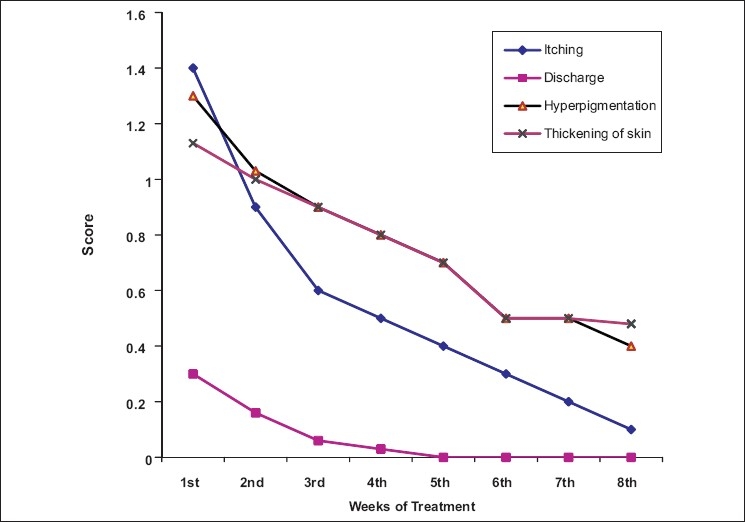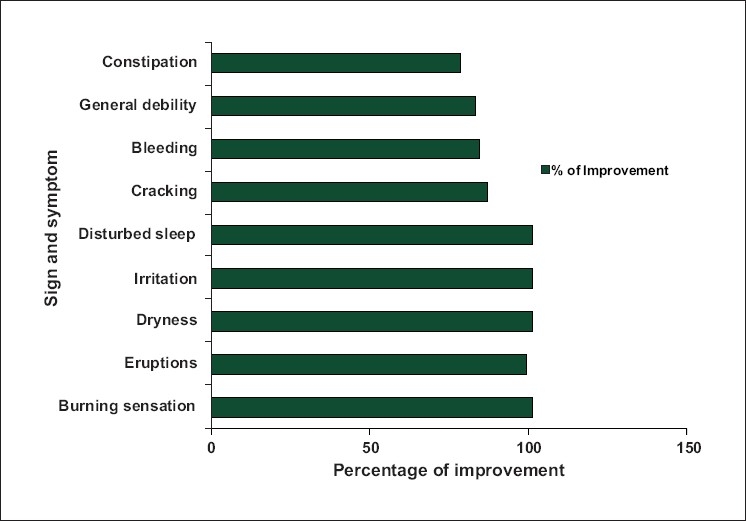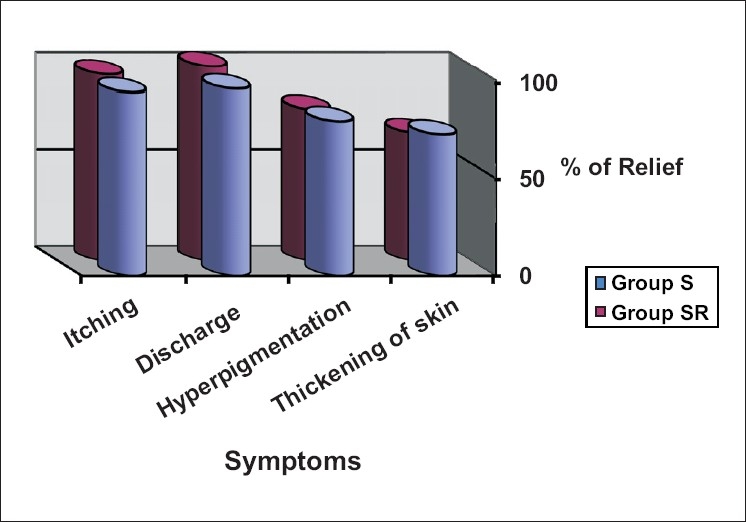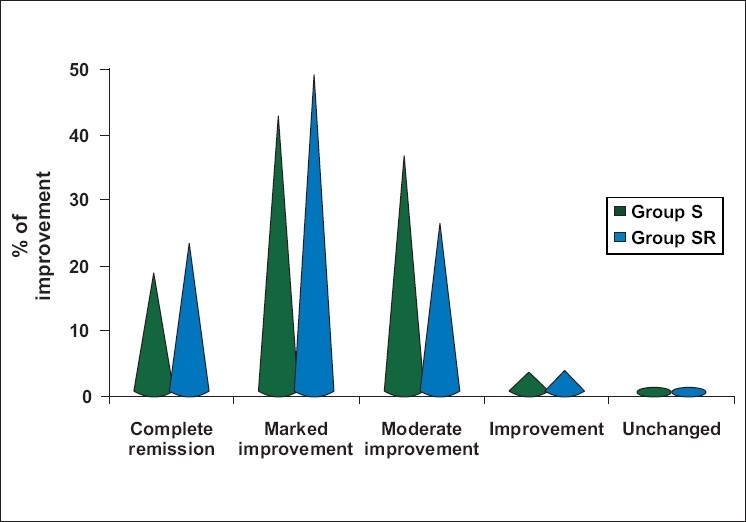Abstract
Generally, skin diseases run a chronic course and the recurrence is very common. Mandip and Chandola (2009) reported that Shirishadi Decoction administered orally and simultaneously Snuhyadi Lepa applied externally to the patients of Vicharchika (Eczema) provided complete remission to 18.2% patients, marked improvement to 42.4% patients and moderate improvement to 36.4% patients but the recurrence rate was very high i.e. 80%. Charaka, in the context of the treatment of Apasmara mentions that in all the chronic diseases, Rasayana drugs should be prescribed. As eczema is a chronic disease and its recurrences are very common, therefore, it was thought desirable to evaluate the role of the Rasayana drugs in the cure and prevention of the recurrence of Vicharchika (Eczema). In this study, total 38 patients of Vicharchika (Eczema) were registered, among which 31 patients completed the full course of treatment. These patients were first subjected to Koshtha Shuddhi done with Aragvadha (Cassia fistula) Hima administered orally at bedtime for initial eight days. Thereafter 30 ml of Shirishadi Decoction and 6 gm of Guduchi (Tinospora cardifolia) and Bhringaraja (Eclipta alba) powder was given with Ghrita. Both the drugs were given twice daily after meals orally. Simultaneously, Snuhyadi Lepa was applied on the eczematous lesions. Results of the study showed that addition of Rasayana drugs provided complete remission to 22.6% and checked the recurrence of the disease in the 89.5% patients of Vicharchika (Eczema).
Keywords: Vicharchika, Rasayana, Koshtha Shuddhi, Shirishadi Decoction, Snuhyadi Lepa, Guduchi- Bhringaraja Rasayana, Eczema, Recurrence
Introduction
Vicharchika, according to Ayurveda is Rakta Pradoshaja Vikara having involvement of three Dosha with dominance of Kapha1. Though, it is Kshudra Kushtha, it runs a chronic course and has a tendency of exacerbations. Vicharchika can be co-related with eczema from allopathic stand point which is a form of dermatitis, or inflammation of the upper layers of the skin. The term eczema is broadly applied to a range of persistent or recurring skin rashes characterized by redness, skin edema, itching and dryness, with possible crusting, flaking, blistering, cracking, oozing or bleeding. Areas of temporary skin discoloration sometimes characterize healed lesions, though scarring is rare2. Long-standing eczema is often dry and is characterized by thickened, scaling skin with hyper pigmentation and visible criss-cross markings (lichenification)3. In maximum of cases, patients of Vicharchika (Eczema), who do not get cure from the Allopathy Medicine, come to Ayurveda treatment with a great hope for curing their disease. Naturally by the time, they approach to Ayurvedic physician for the help, disease had already attained the chronic state, thus making the job further difficult. Other problem with the skin diseases is of their frequent recurrence for which, also the definite answer has to be worked out.
So it is our foremost duty to find out the definite solution for these two major problems of the modern era. Mandip and Chandola (2009)4 carried out a clinical study to evaluate the role of Shirishadi Decoction administered orally and simultaneously Snuhyadi Lepa applied externally in the management of the patients of eczema. This combination provided complete remission to 18.2% patients, marked improvement to 42.4% patients and moderate improvement to 36.4% patients but the recurrence rate was very high i.e. 80%.
In the context of the treatment of Apasmara, Charaka has mentioned that in all the chronic diseases, Rasayana drugs should be prescribed5 But to get maximum benefit of Rasayana therapy it is essential to perform Shodhana prior to administration of Rasayana6. Shodhana is a long process and hence in the present study, before administration of the Rasayana drugs Koshtha Shuddhi was done in the patients with Aragvadha.
Sharma and Singh (1989)7 evaluated the role of Rasayana in the cure of urticaria wherein it was concluded that if the Guduchi and Bhringaraja Rasayana, when added to the anti urticaria drug viz. Udarda Prashamana powder, the cure rate of the patients of Shitapitta (urticaria) was increased from 27.3% to 71.4%. So this combined therapy was considered as ideal for the treatment for Shitapitta (urticaria). These findings were reconfirmed by Ramajiyani and Singh (1992)8 and Dobaria and Singh (1997)9. Taking all these points into consideration this study was planned to ascertain whether addition of Rasayana drugs to the treatment of Vicharchika enhances the cure rate or prevents its recurrence.
Shirishadi Decoction and Snuhyadi Lepa used by Mandip and Chandola were selected as the treatment drug. For Rasayana effect, Guduchi and Bhringaraja were selected. Guduchi is Kushthaghna, Rasayana, and has proved to have anti allergic, anti-oxidant, immunostimulant and hepatoprotective properties10. Similarly Bhringaraja is Kushthaghna, Rasayana and Keshya. It also possess anti oxidant, anti inflammatory, anti leprosy, haematinic and tonic actions11. Further as mentioned above earlier workers also reported the beneficial effects of Guduchi and Bhringaraja in the skin disease such as Shitapitta (Urticaria), therefore both of these drugs were selected as Rasayana drugs.
Prior to the administration of Rasayana it is necessary to perform Shodhana at least cleaning of bowel (Koshtha Shuddhi) with purgative drug, therefore in this study for Koshtha Shuddhi a simple drug Aragvadha (Cassia fistula) was selected. The aim of the study was to evaluate the role of Guduchi and Bhringaraja Rasayana powder along with Shirishadi Decoction and Snuhyadi Lepa in the management of Vicharchika (Eczema).
Material & Methods
Total 38 patients of Vicharchika (Eczema) were registered from the OPD and IPD of Kayachikitsa department of IPGT&RA Hospital, Gujarat Ayurved University, Jamnagar for this study, out of which 7 were dropped-out and 31 patients completed the prescribed course of the treatment12.
Criteria of Diagnosis
The diagnosis was mainly based on the clinical presentation of Vicharchika (Eczema) as mentioned in the Ayurveda and Allopathic texts.
Exclusion criteria
Patients of Vicharchika having secondary infections.
Patients suffering with Diabetes mellitus.
Patients of status eczematous condition.
Investigations
Routine and microscopic examination of urine and stool
Routine hematological investigation for Total Leucocyte Count, Differential count, Hemaglobin%, ESR.
Skin scrap test was done to exclude ring worm in doubtful patients.
Drugs, dose and duration
The patients were first subjected to Koshtha Shuddhi. For this purpose Aragvadha Hima made from 10gm of Aragvadha Phala Majja was used. Thereafter, the patients were treated with Shirishadi Decoction administered orally in the dose of 30 ml and 6gm of Rasayana drug comprising of equal parts of powder of Guduchi (Tinospora cardifolia) and Bhringaraja (Eclipta alba) twice daily with Ghrita after meal. Simultaneously, after cleaning the lesions with warm water, Snuhyadi Lepa was applied externally on the lesions twice a day. Duration of treatment was 60 days.
Method of Preparation of the Drugs
Aragvadha Hima: For preparation of the Hima, 10 gm pulp of Aragvadha (Cassia fistula Linn.) was soaked in 40 ml of water for 12 hours and then it was squeezed through a coarse cloth and liquid thus obtained was given orally at bedtime for initial eight days for cleaning of bowel (Koshtha Shuddhi).
Shirishadi Decoction: This decoction was prepared by taking equal parts of coarse powder of Shirisha (Albizzia lebbeck Linn. Willd), Nimba (Melia azadirachta Linn.), Sariva (Hemisdesmus indicus R. Br.), Kantakari (Solanum xanthocarpum), Khadira (Acacia catechu Willd.) and Saptaparna (Alstonia scholaris R. Br.). To this powder, 16 times water was added and reduced to one fourth by heating on slow fire.
Snuhyadi Lepa: For the preparation of Snuhyadi Lepa, thick stems of Snuhi (Euphorbia neriifolia Linn.) were taken. After removing the thorns, its pulp was taken out with knife and the hollow space thus obtained was filled with coarse powder of seeds of yellow Sarshapa (Brassica campestris Linn. Var.), and pulp of Snuhi. It was kept in oven at fixed temperature (80 degree C) for about 4 to 5 days, till it became dry to powder. Thereafter, it was taken out from the oven, made in the form of powder and then filtered through 80 sized sieves. To this powder, Mustard (Sarshapa) oil was added in the ratio of 1:4 and filled in cleaned bottles with tight lid. Before using, it was mixed well and applied on the lesions twice a day.
Guduchi-Bhringaraja Rasayana: Equal part of powder of Guduchi (Tinospora cardifolia Willd) and Bhringaraja (Eclipta alba Hassk) was taken.
Assessment of the effects of the therapy: To assess the effect of the therapies suitable scores to each of the signs and symptoms of the disease were assigned. The overall effect of the treatment was assessed as follow:
Complete remission: 100% relief in the signs and symptoms along with plain skin surface with significant change of the color of the affected skin nearly to normal.
Marked improvement: 100% relief in the signs and symptoms but slight presence of pigmentation and/or thickening of the skin.
Moderate improvement: More than 50% relief in the signs and symptoms with marked improvement in pigmentation and thickening of the skin.
Improvement: Less than 50% relief in the signs and symptoms with slight improvement in pigmentation and thickening of the skin.
Unchanged: No relief in the signs and symptoms.
Follow-up Study
After completion of full course of the treatment, the patients were asked to report at the fortnight interval for follow-up study for the period of two months. During the visit the patients were enquired for the relapse of the disease. In such patients where the drug provided partial relief was enquired whether there was exacerbation in their symptoms during the period.
Results
The maximum patients of this series i.e. 68.4% were in the age group of 21-50 years, 57.9% were male, 21.1% were housewives and 34.2% were laborer, 84.2% were married, 84.2% were Hindu, 55.3% were belonging to middle class of the society and 76.3% were Vegetarian.
The effect of the therapy on the main symptoms such as itching, discharge, hyper-pigmentation and thickening of skin were evaluated every week of the treatment, which are depicted in Table 1–4 respectively (Figure 1).
Table 1.
Week wise improvement recorded in itching of 31 patients of Vicharchika (Eczema)

Table 4.
Week wise improvement recorded in thickening of skin of 31 patients of Vicharchika (Eczema)

Figure 1.

Week wise improvement in the symptoms of Vicharchika (Eczema)
Table 2.
Week wise improvement recorded in discharge of 31 patients of Vicharchika (Eczema)

Table 3.
Week wise improvement recorded in hyper pigmentation of 31 patients of Vicharchika (Eczema)

The effects of the therapy on the other signs and symptoms recorded in the patients of this series have been shown in Table 5 (Figure 2). The effect of the therapy was also noted on the Dushti Lakshana of Dosha, Srotasa and Tvak, which have been shown in Table 6. The therapy significantly reduced the eosinophil count as shown in Table 7. The next Table 8 depicts the overall effects of the therapy and in the Table 9 the results of follow up study have been depicted.
Table 5.
Effect of the treatment on the other signs and symptoms of 31 patients of Vicharchika (Eczema)

Figure 2.

Effect of therapy on other sign and symptoms:
Table 6.
Effect of the treatment on the Dosha, Srotasa & Tvak Dushti of 31 patients of Vicharchika (Eczema)

Table 7.
Effect of the treatment on the Hematological values of 31 patients of Vicharchika (Eczema)

Table 8.
Overall effect of Shirishadi Decoction and Snuhyadi Lepa and Rasayana on the 31 patients of Vicharchika (Eczema):

Table 9.
Result of follow up study

Effect of Shirishadi Decoction, Snuhyadi Lepa and Rasayana
After performing Koshtha Shuddhi with Aragvadha, 31 patients of Vicharchika (Eczema) were treated simultaneously with Shirishadi Decoction, Guduchi-Bhringaraja Rasayana and Snuhyadi Lepa for the period of two months. This therapy provided significant relief in the symptoms like itching (95.8%), burning sensation (100%), eruption (98.2%), discharge (100%), dry skin (100%), hyper pigmentation (77.7%) and thickening of the skin (65.7%). It also provided significant improvement in the symptoms of irritation (100%), disturbed sleep (100%), cracking (86.5%), bleeding (83.6%), indigestion (94.3%), general debility (82.4%), constipation (77.7%) giddiness (74.4%), blackouts (75%) and anorexia (66.7%).
The drugs of this group gave significant improvement in Dushti symptoms of Vata (68.4%), Pitta (91.5%), Kapha (62.4%), Tvak (53.2%) and Raktavaha (76.5%), Mamsavaha (73.9%) and Svedavaha (70.6%) Srotasa. It also significantly reduced eosinophil count by 64.7%.The week wise improvements recorded in this group in the main symptoms like itching, discharge, hyper-pigmentation and thickening of the skin have been shown in Table 1 to 4 respectively (Figure 1).
Total effect: In this group, complete remission was reported in 22.6% patients, marked improvement in 48.4%, patients, moderate improvement in 25.8% patients and improvement in 3.2% patients (Table 8). In this group only 10.5% patients reported recurrence of the disease with few symptoms (Table 9).
Discussion
Comparison of the results of effect of Shirishadi Decoction administered orally along with Guduchi-Bhringaraja Rasayana powder given after performing Koshtha Shuddhi and simultaneously Snuhyadi Lepa applied externally (Group SR) provided better effects to the patients of Vicharchika (Eczema) than Shirishadi Decoction administered orally and simultaneously Snuhyadi Lepa applied externally to the patients of Vicharchika (Eczema) given without Rasayana and Koshtha Shuddhi (Group S).
Mandip and Chandola (2008)4 in their earlier study reported that Shirishadi Decoction and Snuhayadi Lepa provided 93.9% relief in the symptom of itching, whereas in present study in which Rasayana was added the relief in itching was 95.8% (Figure 3). Thus addition of Rasayana provided comparatively little better relief in this symptom. Similarly addition of Rasayana also provided comparatively better relief in discharge In S Group 95.8% and in SR Group 100%: Figure 3.
Figure 3.

Comparsion of effect of s group & sr group on symptoms of Vicharchika (Eczema)
Mandip and Chandola (2008)4 reported that in S Group, 93.9% relief in the symptom of itching was noticed which was maximum in the sixth week and thereafter no further improvement was noticed. Whereas in SR Group, 95.8% relief was found, this was comparatively more persistent as the relief continued in all the weeks of the treatment.
In S group, 95.8% relief in complain of discharge from lesions of the patients of Vicharchika (Eczema) was observed whereas, 100% relief was found in SR Group. Both of these findings were statistically highly significant. In the feature of hyper pigmentation, both the groups provided highly significant effect which 79.3% in S Group and 77.7% in SR Group. Similarly, both the groups provided highly significant relief effect in the feature of thickening of the skin, which was 72.5% in S Group and 65.7% in SR Group (Figure 3).
Comparison of the overall effects of the therapies
Complete remission was found in 18.2% patients in S Group while 22.6% patient reported complete remission in SR Group. Marked improvement was noticed in 42.4% and 48.4% patients in S Group and SR Group respectively. In S Group moderate improvement was found in 36.4% patient, while in SR Group it was found in 25.8% patient. Improvement was reported in 3% and 3.2% of patients respectively in S Group and SR Group respectively (Figure 4).
Figure 4.

Comparsion of overall Effect of Group S & Group SR
The results of the follow up study showed that recurrence of eczema in S Group was in 80% patients whereas recurrence reported in SR Group was only 10.5% patients.
It is obvious from the foregoing comparisons of the results of the earlier study and present study that addition of Rasayana to the Shirishadi Decoction and Snuhyadi Lepa significantly prevents the recurrence of the disease as no recurrence was reported in 80% patients in SR group. However there was not much increase in the cure rate because it remains 22.6% in SR group which was 18.2% in S group. The reason may be that in the texts it is mentioned to administer Rasayana drugs after Shodhana while in the present study we had administered Rasayana only after Koshtha Shuddhi by Aragvadha. Therefore it is suggested that another study may be carried out in which Rasayana drugs and other drugs may be administered after proper Shodhana as per classical method.
Conclusion
On the basis of the results of this study it may be concluded that addition of Guduchi-Bhringaraja Rasayana to Shirishadi Decoction and Snuhyadi lepa significantly checked the recurrence of eczema as in this group no recurrence was reported in 89.5%. However, no much increase in the cure rate was found in comparison to earlier study as it was 22.6% in Rasayana group and 18.2% without Rasayana group.
References
- 1.Part II, reprint. 30. Vol. 7. Varanasi: Chaukhambha Bharati Academy; 2006. Agnivesha, Charaka Samhita, Vidyotini Hindi commentary by Kashiram Shastri and Gorakhnath Chaturvedi; p. 253. Chaukhambha Bharati Academy. [Google Scholar]
- 2. [accessed on 21/02/2009]. hhtp://pagead2.googlesyndication.com/pagead/ads?client=Ca-pub-3339185, H:\plants \ Eczema-Article. htm .
- 3.Kasper: Harrison's Principles of Internal Medicine. 16th edition. Mc Graw Hill Medical Publishing Divison: New Delhi; 2004. p. 289. [Google Scholar]
- 4.Kaur Mandip, Chandola HM. Effect of Shirishadi Decoction and Snuhyadi Lepa on the patients of Vicharchika (Eczema) AYU. 2009;30(1):16–21. [Google Scholar]
- 5.Ibid. Charaka Samhita. 10(65):339. [Google Scholar]
- 6.Ibid. Charaka Samhita. 1-1(24):9. [Google Scholar]
- 7.Sharma Mohanlal, Singh Gurdip. M.D. Thesis. Jamnagar: I.P.G.T. R.A; 1989. A study on the prevention and cure of Shittapitta with Udardaprashamana Churna and Rasayana. [Google Scholar]
- 8.Ramjiyani B.V, Singh Gurdip. M.D. Thesis. Jamnagar: I.P.G.T. R.A; 1992. The role of Kashtha Aushaddhi and Rasayana in the management of Shittapitta, M. [Google Scholar]
- 9.Dobaria Vandana, Singh Gurdip. D.P.C. Thesis. Jamnagar: I.P.G.T. R.A; 1997. A clinical study on the role of Vamana Karma in the management of Shitpitta. [Google Scholar]
- 10.Data Base on Medicinal Plants used in Ayurveda. 1st edition. III. New Delhi: CCRAS; 2001. Anonymous; p. 257. [Google Scholar]
- 11.Ibid. (10) II:113–114. [Google Scholar]
- 12.Kaur Mandip, Chandola H.M. Ph.D. Thesis. Jamnagar: I.P.G.T. R.A; 2001. Role of Shamana and Rasayana Therapies in the Management of Vicharchika (Eczema) [Google Scholar]


